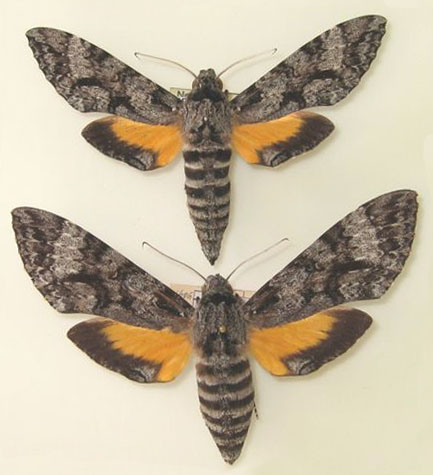|
|
Updated as per More, Kitching and Cocucci's Hawkmoths of Argentina 2005, December 2009
Updated as per
AN ANNOTATED CHECKLIST OF THE SPHINGIDAE OF BOLIVIA, December 2009
Updated as per French Guiana Systematics: Sphingidae; May 12, 2011
Updated as per CATE (Venezuela, Bolivia, western Argentina, Brazil; description); May 12, 2011
Updated as per "A Hawk Moths fauna of southern Maranhão state, Brazil, ... "; NEVA: Jahrgang 34 Heft 3 November 2013; via Jean Haxaire; April 5, 2014
Updated as per personal communication with Ezequiel Bustos (Shilap revta. lepid. 43 (172) diciembre, 2015, 615-631 eISSN 2340-4078 ISSN 0300-5267), January 4, 2016
|
Isognathus menechus
(Boisduval, [1875]) Anceryx menechus

Isognathus menechus pair, Mato Grosso, Brazil, courtesy of
Eurides Furtado.
This site has been created by
Bill Oehlke at oehlkew@islandtelecom.com
Comments, suggestions and/or additional information are welcomed by Bill.
TAXONOMY:
Family: Sphingidae, Latreille, 1802
Subfamily: Macroglossinae, Harris, 1839
Tribe: Dilophonotini, Burmeister, 1878
Genus: Isognathus G. Felder & R. Felder, 1862 ...........
Species: menechus (Boisduval, [1875])
|
MIDI MUSIC
.....It's a Wonderful World.....
copyright C. Odenkirk
ON.OFF
<bgsound src="world.mid" LOOP=FOREVER>
|
DISTRIBUTION:
Isognathus menechus
(Wing span: 90-92mm, females: 100mm),
flies from Cuba to
Venezuela;
French Guiana: Saint-Georges l'Oyopok; Matoury;
Bolivia: Cochabamba, Santa cruz;
Argentina: Tucuman; and
Brazil: Para; Alagoas: Leopoldina; Federal District: Brasilia; Mato Grosso; southern Maranhao;
with Cuba given as
the specimen type locality.
Possibly there are populations in Colombia WO??
The body and forewings have a bluish-grey cast.
The forewings have double antemedian and double postmedian lines, which are distinct at tthe costal margin.
The pm pair is interrupted at M3, then reappear posteriorly,
forming a semicircle opening towards the anal angle. An elongate black patch between M3 and CuA1 merges basally with the postmedian lines.
The distal white vein-streaks are usually conspicuous.
FLIGHT TIMES:
There are probably several flights
throughout the year. Specimens have been taken in French Guiana in May and November-December.
ECLOSION:
Moths emerge from pupae in thin-walled cocoons
under leaf litter within 8-24 days of pupation.
SCENTING AND MATING:
Females call in the males with a pheromone released from a gland at the tip of
the abdomen. Adults nectar at flowers, including petunia.
EGGS, LARVAE, PUPAE:
Females probably lay eggs on leaves of Apocynacea.
Himatanthus lancifolius
has been reported as a host in Brazil.
Larvae have
long tails; colouration suggests they are unpalatable to birds.
The pupae are also quite colourful, and, I suspect,
are very lively. Moths generally emerge within 8-24 days of pupation.
Return to Sphingidae Index
Return to Dilophonotini Tribe
